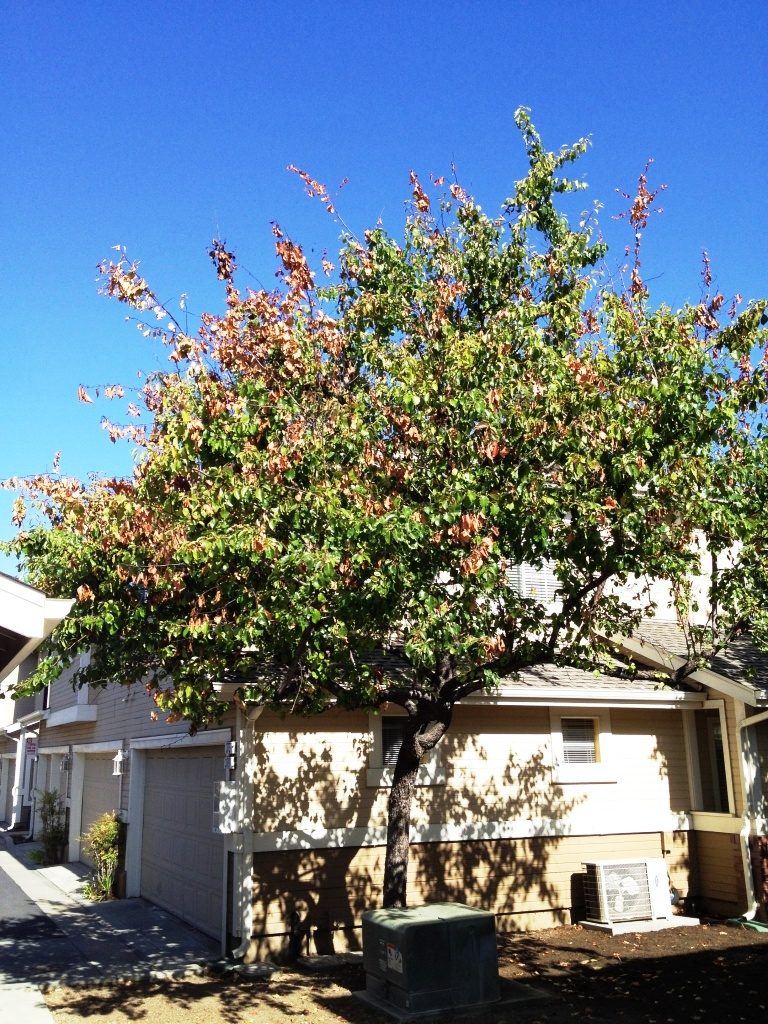Common Tree Diseases in California Cities
Do your usual tree management tactics seem to be falling short? The California climate, temperature extremes, and pollution can certainly do a number on landscaping, impacting tree health. However, the Arborwell team knows that disease may also be to blame. How can you distinguish environmental stress from illness? Check the trees on your California property regularly, watching for signs of these common tree diseases.
Anthracnose
Anthracnose is a fungus that affects a variety of plants and trees. It thrives in warm, moist conditions and multiplies very quickly during rainy spells, spreading through infected plant debris. Our plant health care experts identify it by the dark, sunken lesions it produces on affected flowers, fruits, leaves, and stems, which begin as small, irregular yellow-brown spots that darken and spread. Fortunately, with proper tree care from our knowledgeable arborists, anthracnose is not lethal.
Fire Blight
The Arborwell team frequently encounters this bacterial disease in the early spring. Though it doesn’t affect a wide variety of tree types, it is incredibly contagious and can cause significant damage very quickly. Fire blight attacks all parts of the tree, including blossoms, leaves, and branches, giving them a dark brown or black scorched appearance. It spreads through many vectors, including wind, rain, insects, and birds, and is frequently seen on California’s apple and pear trees. Left unchecked, it can kill a tree, necessitating removal and replacement.
Fusarium Wilt
Fusarium wilt is another widespread fungus we frequently see throughout the state. It is known for attacking food crops such as tomatoes and bananas and is one of many diseases affecting California palm trees. Fusarium oxysporum can live indefinitely in the soil without access to a living host and spreads easily, making it difficult to eradicate. The infection begins in the roots, interfering with water transport, causing lower (older) leaves to wilt and yellow. The disease then progresses to new growth until the plant eventually dies.
The Role of Pests and Disease
Experienced arborists know that weak and diseased plants are naturally more susceptible to pests. Infestations can quickly go from being an unsightly nuisance to a major problem, claiming the life of the trees on your commercial property. Watch out for these common offenders on sick or diseased trees:
- Royal palm bugs
These tiny, oval, yellowish bugs feed only on the freshly opened leaves of royal palms. Though they can make your palms weak and unattractive, if addressed quickly, we can save your trees. - Cabbage palm caterpillar
Cabbage palm caterpillars feed on palm flowers, weakening the tree. Their reddish-brown larva also stains the tree, leaving behind an ugly mess. - Palmetto weevils
If young leaves on your palm trees are wilting and quickly dying, you may have palmetto weevils. If you don’t eradicate them fast, these black or red-winged pests can quickly kill your trees. - Gold spotted oak borers
These tiny, invasive beetles kill oak trees and are fundamentally changing the landscape in the region. - Oak worms
Oak worms feed on oak leaves, quickly consuming lush canopies to leave behind a scruffy, leafless tree. Caterpillars fall off trees en masse in May, littering patios, cars, and people.
Identify and manage common tree diseases in California cities with the help of Arborwell Professional Tree Management. Fill out our online form to schedule an arborist assessment for your ailing trees, or contact us at today.
Anthracnose, Fire Blight, fusarium wilt, tree health, tree management


